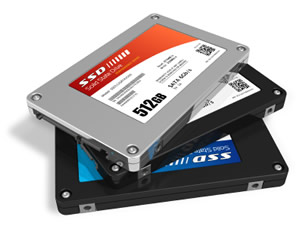Are you in the market for a newer, faster computer, or perhaps thinking about upgrading your current one? Computers should be so advanced these days that anything you do on them should happen almost instantly. The introduction of Solid-State Drives, or SSDs, is the easiest and most effective way to speed up any computer. If you’ve never heard of SSDs before, then continue reading for some of the main benefits that they provide.
The first and most obvious SSD benefit is that they provide a much-needed boost of speed. While Solid State Drives have the same function that regular hard drives do — storing files and other information — th
The speed increase is impressive. When you install a Solid State Drive in a standard computer, you can expect it to boot up in 10 seconds or less in most cases, as opposed to the 50+ seconds that traditional hard drives require. Opening programs like Adobe Photoshop or Microsoft Excel is almost instantaneous.
Not only are solid state drives faster than traditional hard drives, but they’re more durable as well. As mentioned before, an SSD has no moving parts that could break if it’s dropped or shaken. While a traditional hard drive could be broken beyond repair, including data loss, in those situations. Also, while regular hard drives have a tendency to wear out over the years, an SSD is manufactured in such a way that most consumers can expect consistent performance over time.
If you are still using a conventional hard drive, there has never been a better time to upgrade. Prices for SSDs have finally dropped to under $1 per Gigabyte, making them one of the best hardware upgrades available.
If you’ve been wanting a way to speed up your computer, or to guarantee that your new one is fast, pick up a Solid State Drive. You’ll be glad you did!
| Attribute | SSD(Solid State Drive) | HDD (Hard Disk Drive) |
| Power Draw / Battery Life | More power draw, averages 6 – 7 watts and therefore uses more battery | |
| Cost | Expensive, $1.00 per gigabyte (based on buying a 240GB drive) |
|
| Capacity | Typically not larger than 512GB for notebook size drives | |
| Operating System Boot Time |
Around 40 seconds average bootup time | |
| Noise | Audible clicks and spinning can be heard | |
| Vibration | The spinning of the platters can sometimes result in vibration | |
| Heat Produced | HDD doesn’t produce much heat, but it will have a measurable amount more heat than an SSD due to moving parts and higher power draw | |
| Failure Rate | Mean time between failure rate of 1.5 million hours | |
| File Copy / Write Speed | The range can be anywhere from 50 – 120MB / s | |
| Encryption | Full Disk Encryption (FDE) |
|
| File Opening Speed | Slower than SSD | |
| Magnetism Affected? | Magnets can erase data |


